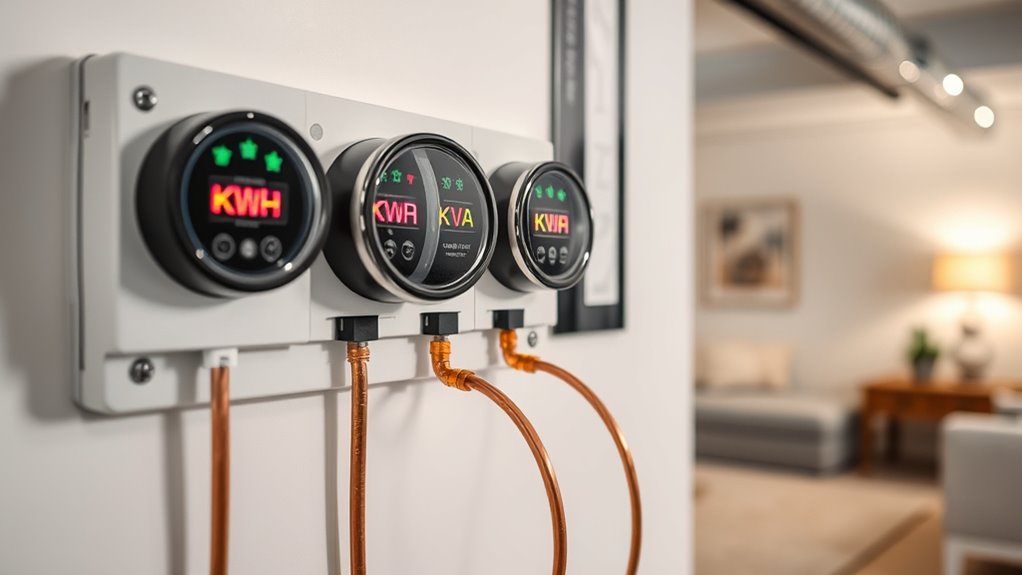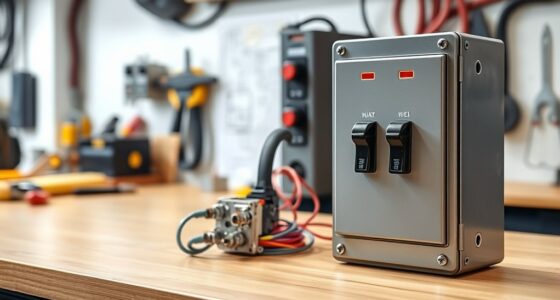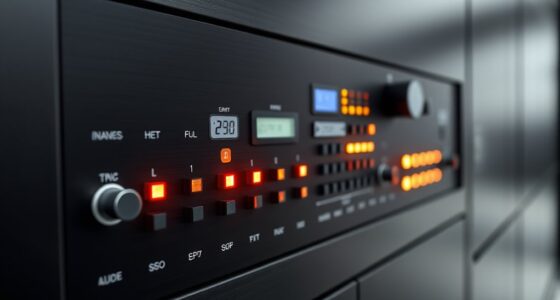In residential systems, kW (kilowatts) measure the actual power used for work, like heating or lighting, while kVA (kilovolt-amperes) account for both real and reactive power, which doesn’t perform useful work but affects current flow. Your equipment is rated in kVA to handle real and reactive loads safely. Understanding this difference helps you size your system correctly and improve efficiency—keep exploring to learn how all this fits together in your home.
Key Takeaways
- kW measures actual energy used by appliances, while kVA accounts for total capacity including reactive power.
- Power factor indicates efficiency; high power factor means kW and kVA are close in value.
- Equipment ratings are often given in kVA to reflect maximum apparent power capacity.
- Low power factor increases current without improving real power, risking system inefficiency and overloads.
- Proper system sizing uses kVA, ensuring safe operation and accounting for reactive power demands.
Understanding the Difference Between Kw and Kva
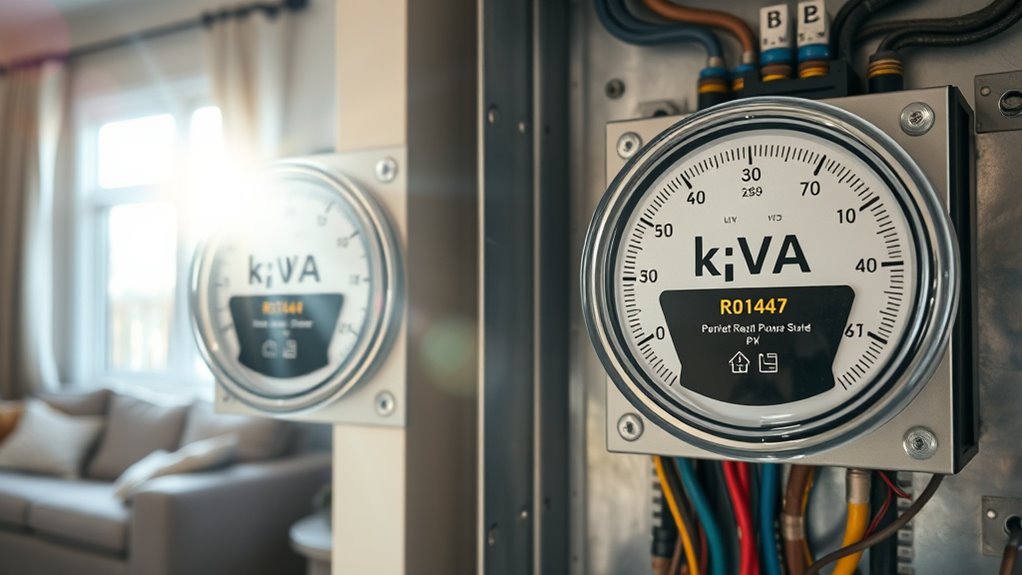
To understand the difference between kW and kVA in residential systems, it’s important to recognize that they measure different aspects of electrical power. kW, or kilowatt, represents *real power*—the amount of energy actually used by your appliances to perform work, like heating, lighting, or running devices. In contrast, kVA, or kilovolt-ampere, measures *apparent power*, which includes both the useful power and reactive power caused by inductive loads like motors. While kW shows how much power you’re consuming, kVA indicates the total capacity your system needs to handle both working and non-working components. Both units are similar in direct current (DC) systems or AC systems with perfect efficiency, but in typical residential setups, they often differ due to power factors. Understanding the power factor of your system helps determine the relationship between kW and kVA, ensuring proper sizing and efficiency.
How Apparent Power and Real Power Interact
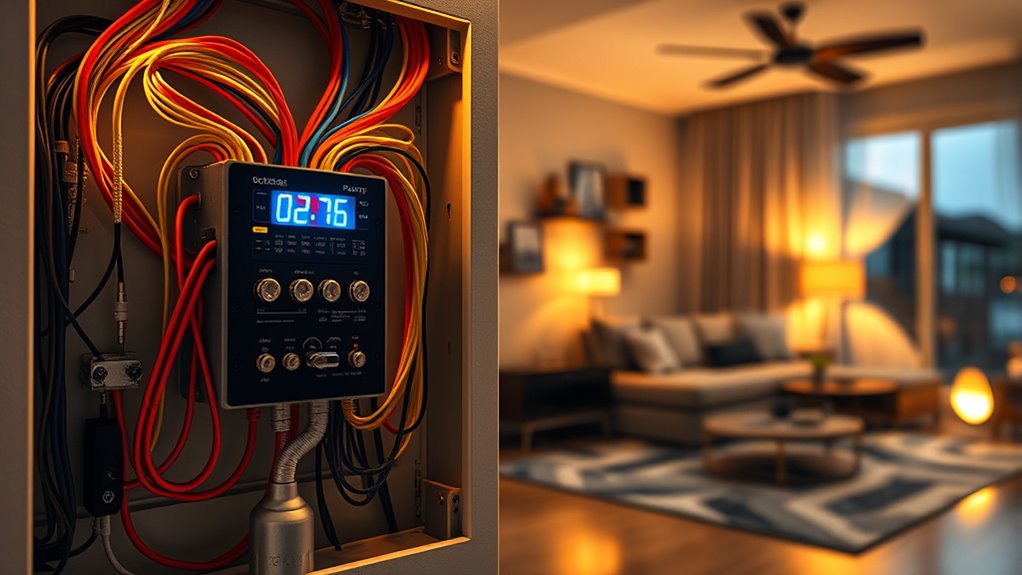
Apparent power (kVA) results from combining real (kW) and reactive power (kVAR) in your electrical system, representing the total power flow. You can visualize this interaction using the power triangle, where real power (P) does useful work like lighting or heating, and reactive power (Q) is stored temporarily by inductive or capacitive loads. The hypotenuse, apparent power (S), reflects the total current and voltage demands. The relationship follows the Pythagorean theorem: ( S^2 = P^2 + Q^2 ). When reactive power increases, apparent power rises, but real power remains unchanged. This interaction impacts how efficiently your system operates, as excess reactive power can cause higher current flow, increased losses, and the need for larger equipment to handle the total power demand.
The Role of Power Factor in Residential Electrical Systems
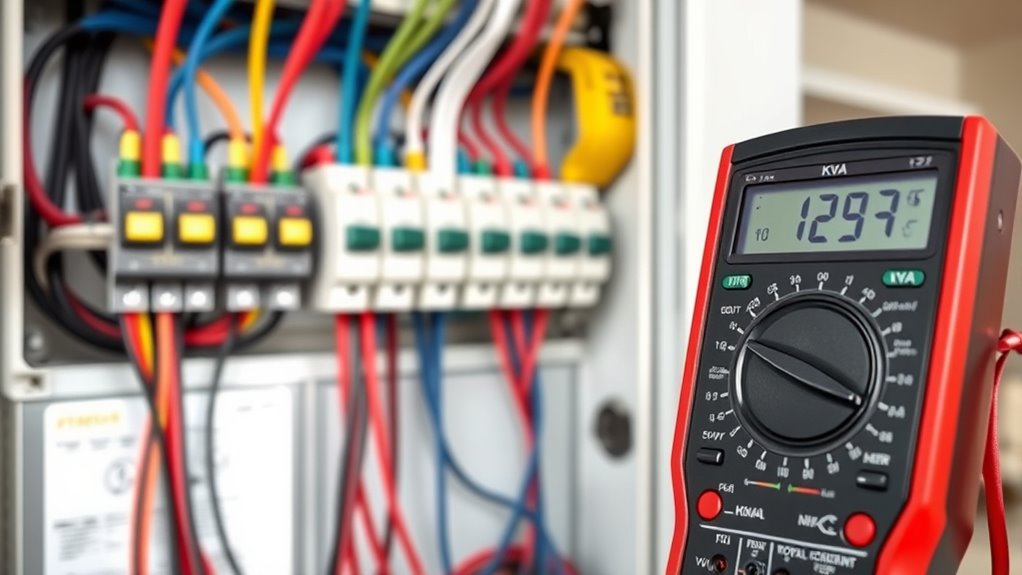
Power factor plays a crucial role in residential electrical systems because it determines how efficiently your home uses electrical energy. A high power factor means you’re making good use of the electrical power you draw, reducing waste and lowering your bills. When your power factor is low, much of the energy is wasted as heat in conductors, increasing the current demand. This extra current can cause larger wiring, more losses, and potential voltage drops, which can harm appliances and reduce performance. Inductive loads like motors and transformers often cause lagging power factors, making correction necessary. Installing power factor correction devices, like capacitors, helps improve efficiency, decrease energy waste, and prevent utility penalties. Maintaining a good power factor keeps your system running smoothly and cost-effectively. Additionally, modern heat pumps incorporate noise reduction technology to operate quietly, ensuring minimal disturbance while optimizing energy use.
Why Equipment Ratings Use Kva Instead of Kw
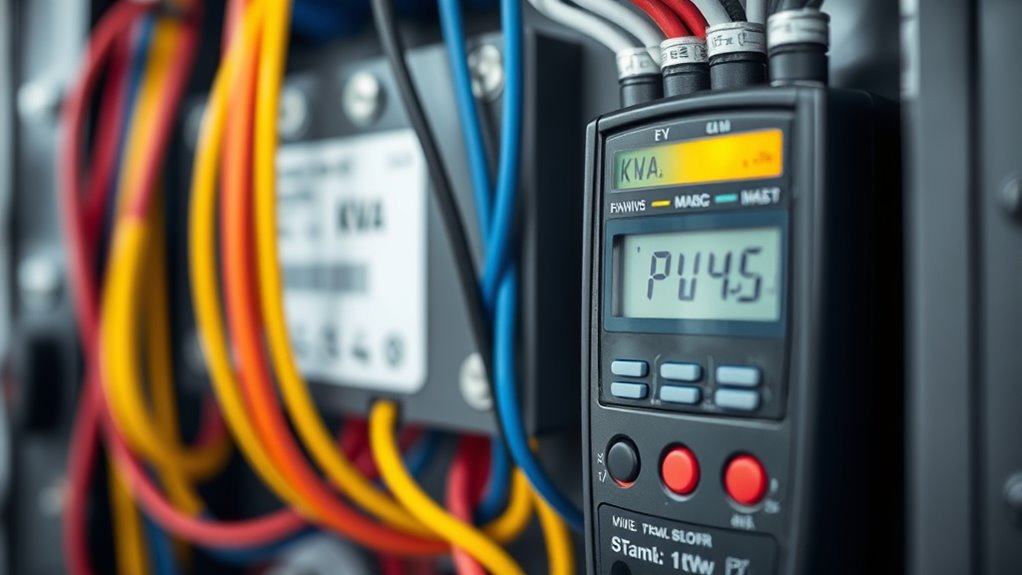
You use kVA ratings because they account for reactive power, ensuring equipment can handle all current flows regardless of load type. This helps in properly sizing equipment so it can operate safely under varying conditions. Sticking to kVA is also the industry standard, making communication and installation more straightforward. Additionally, understanding tax implications of equipment ratings can influence long-term operational costs and compliance.
Handles Reactive Power
Have you ever wondered why electrical equipment ratings are expressed in kVA instead of kW? It’s because equipment needs to handle reactive power, which doesn’t do any work but supports voltage stability. Reactive power oscillates between source and load, maintaining voltage levels crucial for your home’s electrical health. Without it, voltage drops, causing flickering lights or equipment failures. Equipment like transformers and motors rely on reactive power to create magnetic fields, requiring enough capacity in kVA to manage both active and reactive currents. Properly understanding power factor helps explain why this distinction is important in residential systems.
Ensures Proper Sizing
Ever wondered why electrical equipment ratings are expressed in kVA instead of kW? The reason is that equipment like transformers and generators need to handle the total electrical load, including both real and reactive power. kVA provides a complete measure of the apparent power, ensuring the equipment can support fluctuating loads and varying power factors. Relying solely on kW risks under-sizing because it ignores reactive components that increase current flow. Manufacturers rate devices in kVA to guarantee safety margins during different operating conditions and prevent overheating or failure. Using kVA for sizing also helps with compliance to electrical codes and standards, ensuring your system is safe, reliable, and capable of handling the true demands placed on it. KVA reflects the system’s ability to handle both real and reactive power, which is essential for maintaining stable and efficient electrical operation.
Standard Industry Practice
Electrical industry standards favor kVA ratings because they provide a consistent measure of an equipment’s total capacity to handle current, regardless of variations in power factor. This is vital because residential loads often include inductive devices like motors and fluorescent lights that cause the power factor to drop below 1. Using kVA ensures equipment can safely handle the maximum current demand, not just the useful power (kW). It simplifies sizing by accounting for reactive power, which doesn’t do useful work but impacts current flow. Power factor influences equipment performance. Standardized kVA ratings help manufacturers, electricians, and regulators communicate clearly, guaranteeing equipment is correctly sized for varying load conditions. This approach reduces risks of overloads, improves safety, and guarantees compliance with industry codes, making it the preferred practice worldwide. Additionally, using kVA facilitates better system design and coordination among components in residential electrical setups.
Practical Examples of Kw and Kva in Daily Home Use
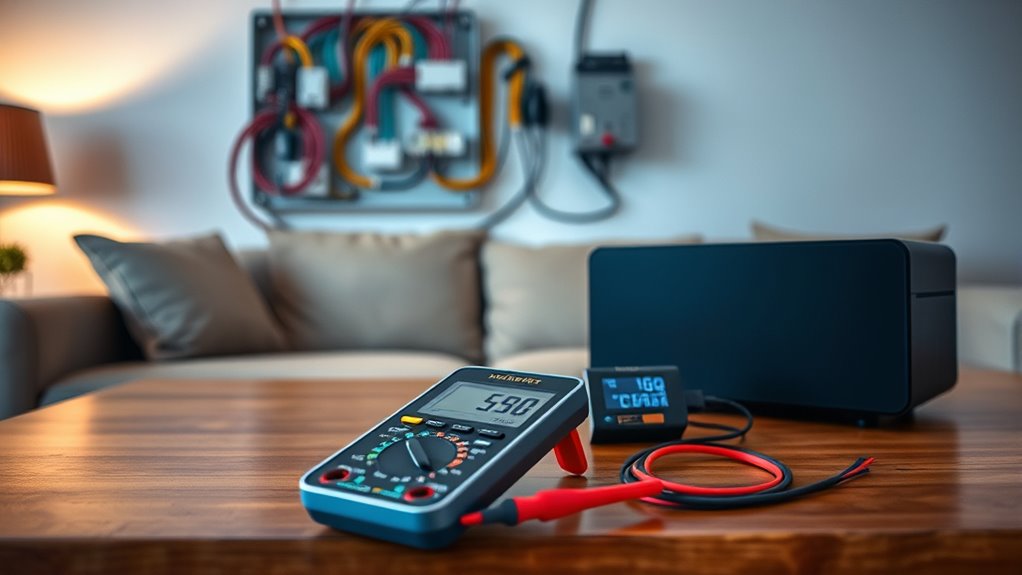
Understanding the difference between kW and kVA is essential when selecting home appliances and backup power systems. For example, a water heater rated at 4.5 kW uses nearly 4.5 kVA since it’s a resistive load with a power factor close to 1. In contrast, a 3.5 kW air conditioner might have an apparent power of around 4.5 kVA because of motor inductance and reactive components. Backup systems like generators and UPS units specify their capacity in kVA; a 5 kVA generator with a 0.8 power factor provides about 4 kW of real power. Knowing these ratings helps you choose the right size equipment to meet your needs, ensuring your appliances operate efficiently without overload. This understanding also aids in selecting appropriate wiring and circuit protections. Additionally, understanding power factor can help optimize energy efficiency and reduce unnecessary electrical costs.
How Power Factor Affects Your Electricity Bill
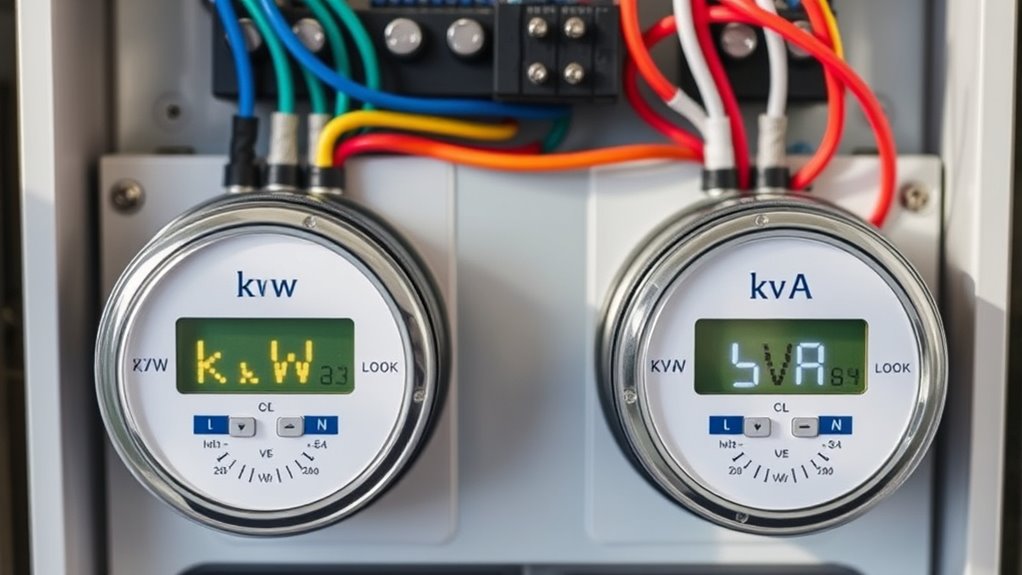
Power factor directly impacts your electricity bill because utilities often impose charges or penalties when it drops below a certain level, typically around 0.80 to 0.90. When your power factor is low, you’re using more reactive power, which stresses the grid and increases costs for utilities. This often results in surcharge penalties, scaling from 2% to 80%, depending on how low your power factor drops. Improving your power factor reduces these surcharges, lowering your bill. Here’s a quick look at how different power factors affect costs:
| Power Factor | Penalty Surcharge | Effect on Bill |
|---|---|---|
| 0.95 | None | No extra charge |
| 0.85 | 2% | Slight increase |
| 0.70 | 20% | Significant increase |
| 0.50 | 80% | High surcharge |
| 0.30 | Excessive | Hefty penalty |
Maintaining a high power factor saves you money and reduces stress on electrical systems. Power factor measures how effectively electrical power is being used, and improving it can prevent these costly penalties. Proper power factor correction can optimize your energy consumption and avoid unnecessary charges.
The Importance of Correctly Sizing Home Electrical Components
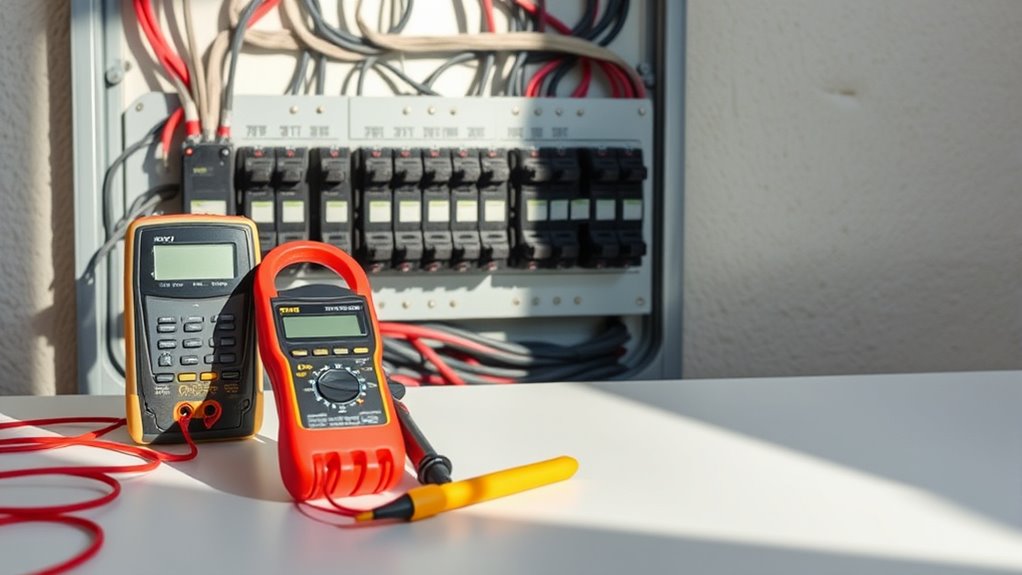
Choosing the right size for your home’s electrical components is crucial to guarantee safety, efficiency, and future readiness. Proper sizing ensures your system can handle current loads without risking overloads or fires. An undersized panel or breaker can cause frequent trips and damage, while an oversized one wastes space and money. To get it right:
Choosing the right electrical size ensures safety, efficiency, and future readiness for your home.
- Match your panel size to your household’s amperage demand, considering current and future needs.
- Select circuit breakers that correspond accurately to the appliances and wiring gauge.
- Perform load calculations to prevent under or over-sizing your system.
- Follow NEC and local codes for safety, compliance, and ease of upgrades.
- Proper sizing also helps in maintaining voltage stability and preventing potential hazards within your electrical system. Ensuring your system is adequately rated is essential for long-term reliability and safety.
Correct sizing reduces risks, maintains efficiency, and extends the lifespan of your electrical system.
Methods to Improve Power Factor at Home
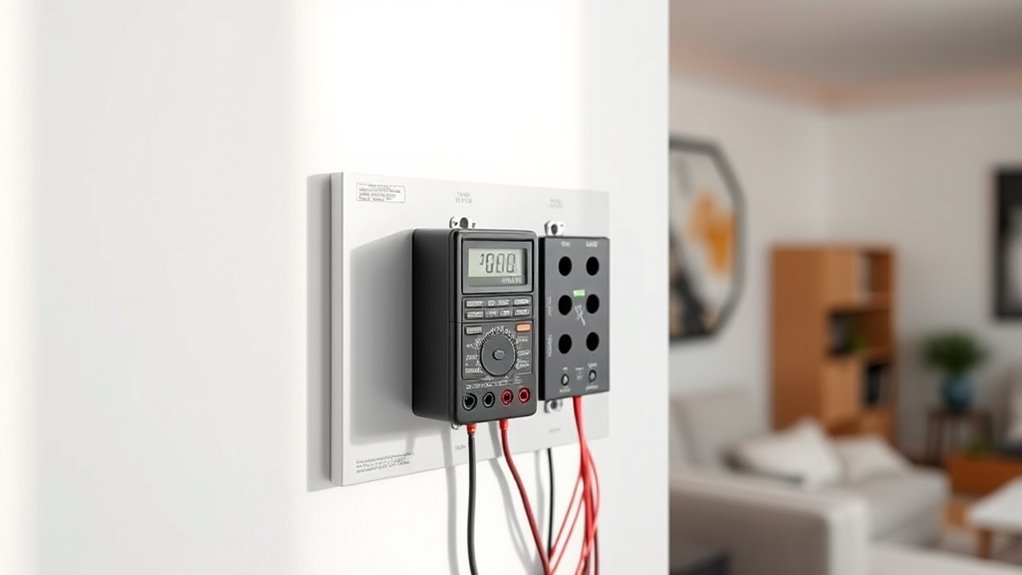
Improving your home’s power factor helps optimize energy use and reduces strain on the electrical system. You can install power factor correction devices at the main meter, using commercial-grade equipment designed for residential settings. Capacitor banks are a common, cost-effective method to offset inductive loads like motors, especially with automatic control panels that adjust based on demand. Configuring solar and battery inverters to supply reactive power can also enhance your power factor, supporting voltage stability and grid efficiency. Employing reactive power management techniques can further fine-tune your home’s electrical performance for better efficiency and reliability.
Converting Between Kw and Kva: Simple Calculations
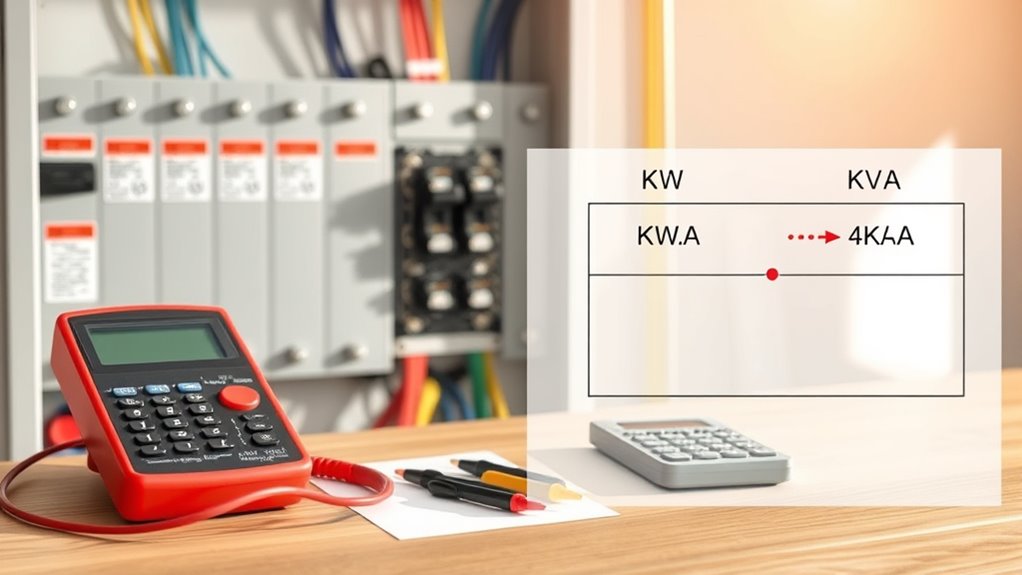
Have you ever wondered how to convert between kilowatts (kW) and kilovolt-amperes (kVA) for your residential electrical system? Converting between these two involves understanding the power factor (PF). Here are key steps:
- To find kVA from kW, divide kW by PF: (kVA = frac{kW}{PF}).
- To convert kVA to kW, multiply kVA by PF: (kW = kVA times PF).
- Use typical residential PF values (around 0.8–1.0) when PF isn’t known.
- For single-phase systems, divide kVA by voltage and multiply by 1000 to find amps.
- Remember, power factor influences the relationship between kW and kVA, so understanding it helps ensure accurate conversions. Additionally, knowing about electric load capacity can help you optimize your system’s performance.
Knowing these formulas helps you estimate power needs accurately and select appropriate equipment. Remember, a lower PF increases kVA for the same kW, impacting your system’s capacity.
Common Mistakes and Misunderstandings About Power Ratings
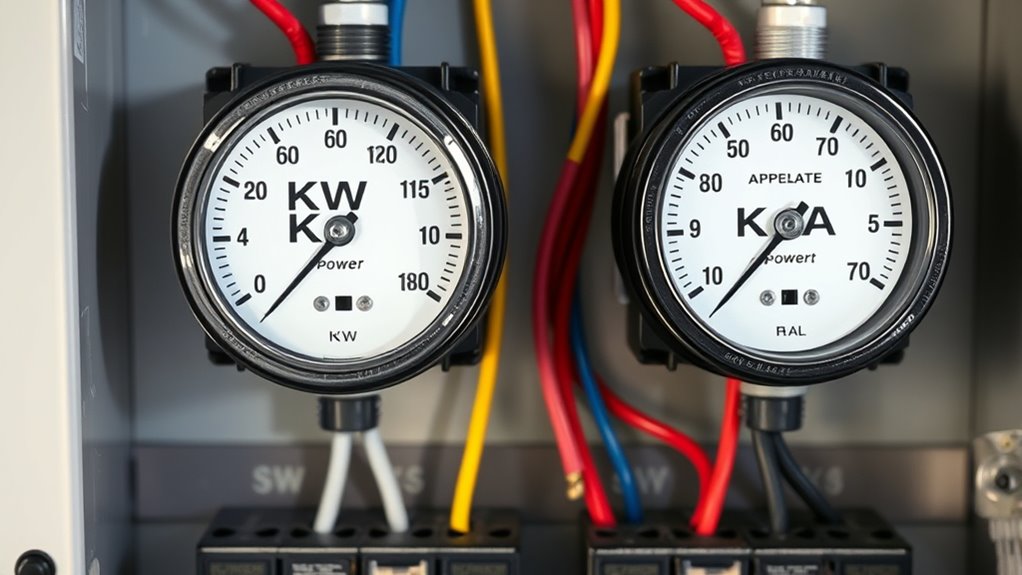
Misinterpreting kW and kVA ratings is a common mistake that can lead to serious issues in residential electrical systems. Many homeowners assume kVA equals usable power, ignoring the impact of power factor. This misjudgment can cause overloads, equipment failures, or inadequate sizing of transformers and generators. To clarify, consider the following:
| Power Rating | Meaning |
|---|---|
| kW | Actual work-performing power |
| kVA | Total apparent power, including reactive |
Overlooking power factor can result in undersized breakers or wires, risking safety. Many systems don’t measure or correct power factor, leading to miscalculations. Additionally, installing equipment based solely on kW without considering kVA may cause premature failure or inefficiency, especially when reactive loads are present. Recognizing these distinctions guarantees safe, efficient, and properly sized residential electrical systems. Understanding power factor is essential for proper system design and safe operation. Proper knowledge of reactive power can also prevent costly errors and enhance system reliability.
Frequently Asked Questions
How Does Power Factor Influence Household Energy Efficiency?
Power factor directly impacts your household energy efficiency by determining how much of your electricity is used effectively. A low PF means more reactive power, which causes your wiring and transformers to work harder, increasing energy losses and costs. By improving your power factor through device adjustments or correction methods, you reduce unnecessary energy waste, lower your utility bills, and lessen your home’s impact on the grid, making your energy use more efficient.
Can Poor Power Factor Cause Home Electrical System Damage?
Yes, poor power factor can damage your home electrical system. When your system has a low power factor, it causes increased current flow, which overheats wires and connections. This overheating can lead to electrical fires, short circuits, and accelerated wear on components. Over time, these issues may cause costly damage or failures in your electrical system, making it essential to address power factor problems promptly with proper correction methods.
Are There Benefits to Installing Power Factor Correction Devices at Home?
Sure, installing power factor correction devices at home might seem like a genius idea to save money. However, for most households, the benefits are minimal—you’re unlikely to see lower bills or better appliance performance. These devices mainly help in commercial settings with heavy motor loads. So, unless you’re running a mini power plant, PFC at home is more about vanity than practical savings or efficiency.
How Do Utility Companies Measure and Bill for Kva Versus Kw?
Utility companies measure kW using meters that track actual energy consumption, and they bill you based on your kilowatt-hours (kWh) and sometimes peak demand. For kVA, they often measure it with specialized equipment for larger customers, but residential bills rarely include kVA charges. Instead, they focus on real power (kW) and energy use. If your home has a big transformer, you might pay a minimum capacity fee based on kVA, but that’s less common.
What Appliances Most Significantly Impact Residential Power Factor?
You might be surprised, but the biggest culprits are your appliances with motors—think refrigerators, air conditioners, and washing machines—that create inductive loads, lowering your power factor. HVAC compressors and older motor designs without correction also play a role. Plus, electronic devices like computers and LED lighting draw non-linear currents, further hurting your PF. Resistive appliances like toasters or electric stoves, however, keep your power factor high and stable.
Conclusion
Understanding the difference between kW and kVA is like knowing the language your home’s electrical system speaks. When you grasp how real power, apparent power, and power factor work together, you gain control over your home’s energy efficiency. Just like tuning a musical instrument, correctly sizing and managing your electrical components guarantees everything runs smoothly. Keep these concepts in mind, and you’ll be in harmony with your home’s electrical needs, avoiding surprises and saving energy.

